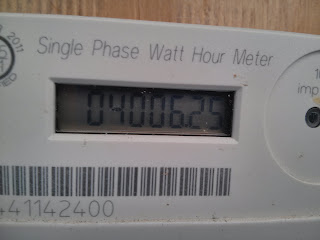The Feed in Tariff (FIT) rate for April onwards is based on RPI inflation rate for the previous December so the 2017 figure will determine the FIT tariff payment level from April 2018.
The FIT tariff level for 2017-2018 was 50.67p per kWh for generation and 3.57p per kWh for export which is deemed as 50% of the electricity generated.
The headline figure of CPI inflation for December 2017 was 3.0% but this isn't the number used to calculate the Feed in Tariff FIT level, the value needed is for RPI inflation which is much harder to find as it's no longer considered an "official" national statistic.
 |
| Solar PV generation meter - FIT rates 2018/19 |
Delving into the ONS statistics page it's eventually possible to locate the RPI number which is 4.1% for December 2017.
So to calculate the new FIT rate we need to multiply the old value of 50.67p by 4.1% which gives a new value of 52.75p for the Feed in Tariff rate as of April 2018-2019. The level for export will increase to 3.72p
https://www.ons.gov.uk/economy/inflationandpriceindices/datasets/consumerpriceinflation